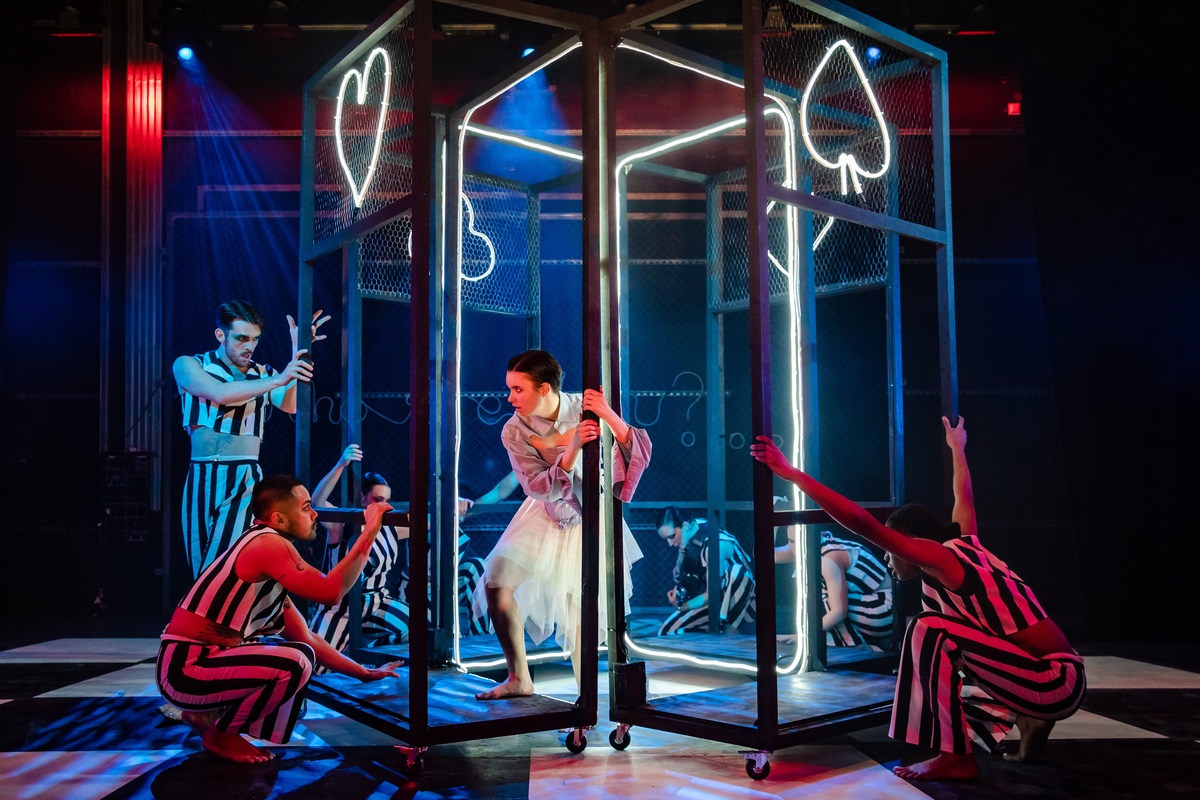Words by Saskia Horton. Saskia took part in our Guest Writers programme, a writers development programme supported by Arts Council England.
Never have I seen a take on this much-beloved classic that is so ground-breaking & canonically Queer. Despite the otherworldly nature of CTC Company’s Wonderland in Alice (and it’s obvious potential to be head-cannoned by LGBT audience with an abundance of queer subtext) previous adaptations have done little to ground the story in a reality we recognise. Instead, leaning into the dissociative dream-like nature of it all.
The live-action films are predictably dark and Tim Burton-esque, the 60s animation classic, whimsical and wayward. And a recent theatre performance by Zoonation: The Mad Hatter’s Tea Party, attempted to relate Wonderland to a world of mental illness, representing the characters as patients in an ‘institution’. A therapist arriving at the scene to ‘cure’ everybody is then dragged into a world of nonsensical folly, erupting into a table-dancing, tea-party. So it seems those investing time in Wonderland adaptations often get drunk off their own fancy. Contrastingly, this avant-garde dance-theatre piece is a grounded take for a story so steeped in surrealism.
The diverse range of well-made characters is a stand-out factor. Each with their own movement language; from the creeping, crawling White rabbit, the Cheshire Cat’s flicking legs & sensuous steps, the Mad Hatter, with rocking grooves & lilting lines and lastly the Red Queen who struts, vogues and serves. It seamlessly portrays an idea about the kinship of a chosen family. That amongst the odd-balls & misfits of Wonderland there can be found, a real sense of community.
“Finding yourself” is a central tenet to the show, illustrated by the blue neon light ablaze on the back wall ingraining the question “Who are you?” in our subconscious from the very beginning. Even the inverted title “Wonderland in Alice” suggests deeper focus on internal exploration than external wonderment. Which is demonstrated as we see Alice escape from all previous definitions of themself through Wonderland. Learning lessons from & interacting with each character, their movement language starts off small, quiet and pedestrian before it builds to a climactic solo. Here, they take up all the space; leaping, bounding, crashing across the stage in a moment of chaos and an expression deeply reminiscent of a ‘Queer becoming’.
The Narrator’s boundless energy stands out above the ensemble. It’s obvious that they (Caitlyn “Acken” Taylor) wrote the entire show. Their scene-stealing presence seems better suited to a west-end stage rather than that of a small community theatre. However, they still blend seamlessly into the fabric, their beat-driven lyricism weaving twirling bodies into a sumptuous soundtrack.
The costume design is perfectly gender-bendy and camp to suit ‘Genderless’ characters, using they/them pronouns, (as described by Christopher Tendai, choreographer). Alice is heroically butch, clad in corset, underwired petticoat & a blue micro-shirt; strongly contrasting the Red Queen who is fantastically trans-femme adorned with glitzy velvet gloves. Even the delicious ‘drink me’ bottles scene, seems to allude to real-life effects of gender transition & defying the binary with the line: “Just the right size, but I cannot get in, no matter the changes I make, I can’t win”.
The set design is a masterful aspect of the work. A lopsided rhombus strip light borders the stage, blurring the characters in fantastic blue-white flashes. Life-size 3D playing cards swoop & slice: taking us down the rabbit hole, into the MadHouse, through the maze to the Queen. The set accentuates the dancers’ movement, giving gravitas to the choreography as well as the illusion that there are more people on stage.
The climax of the piece, however, falls short. After a rousing confrontation between the Queen & Alice, refusing to fight their strong hyper-feminine counterpart anymore, they stumble into an awkward embrace. It is only for a second, but it feels like a missed cue. Perhaps if the hug were relaxed into, it could represent a resolution of sorts. Of Alice embracing their stark opposite, inner conflict or full self. The moment is missed however and unfolds into an overemphatic duet with sickly sweet music.
Overall quality of music production on the night had some distortion and lack of clarity between the layers. Although a notable moment was the ‘club scene’ at the ‘Mad house’ with the Narrator’s bars tripping off the tongue, to pumping beat & driving bass, which contrasted the cheesier ‘musical theatre’ moments, which felt amiss without the rest of the cast bursting into song.
Overall, it is a winning revival of a tried-and-tested narrative. And one that actually has something to say for itself. Through a unique mix of dance, character-work, poetry and design it paints a world, not so dissimilar to our own. Speaking on the real-life trials and tribulations of coming to terms with oneself outside of the confines of boxes that society sets for us.
